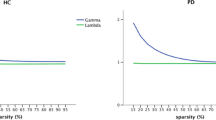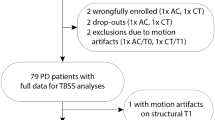Abstract
The effectiveness of cognitive rehabilitation (CR) in Parkinson’s disease (PD) is in its relative infancy, and nowadays there is insufficient information to support evidence-based clinical protocols. This study is aimed at testing a validated therapeutic strategy characterized by intensive computer-based attention-training program tailored to attention deficits. We further investigated the presence of synaptic plasticity by means of functional magnetic resonance imaging (fMRI). Using a randomized controlled study, we enrolled eight PD patients who underwent a CR program (Experimental group) and seven clinically/demographically-matched PD patients who underwent a placebo intervention (Control group). Brain activity was assessed using an 8-min resting state (RS) fMRI acquisition. Independent component analysis and statistical parametric mapping were used to assess the effect of CR on brain function. Significant effects were detected both at a phenotypic and at an intermediate phenotypic level. After CR, the Experimental group, in comparison with the Control group, showed a specific enhanced performance in cognitive performance as assessed by the SDMT and digit span forward. RS fMRI analysis for all networks revealed two significant groups (Experimental vs Control) × time (T0 vs T1) interaction effects on the analysis of the attention (superior parietal cortex) and central executive neural networks (dorsolateral prefrontal cortex). We demonstrated that intensive CR tailored for the impaired abilities impacts neural plasticity and improves some aspects of cognitive deficits of PD patients. The reported neurophysiological and behavioural effects corroborate the benefits of our therapeutic approach, which might have a reliable application in clinical management of cognitive deficits.



Similar content being viewed by others
References
Kudlicka A, Clare L, Hindle JV (2011) Executive functions in Parkinson’s disease: systematic review and meta-analysis. Mov Disord 26(13):2305–2315
Lange KW, Robbins TW, Marsden CD, James M, Owen AM, Paul GM (1992) l-dopa withdrawal in Parkinson’s disease selectively impairs cognitive performance in tests sensitive to frontal lobe dysfunction, Psychopharmacology (Berl.) 107(2–3):394–404
Cerasa A, Gioia MC, Valentino P, Nisticò R, Chiriaco C, Pirritano D, Tomaiuolo F, Mangone G, Trotta M, Talarico T, Bilotti G, Quattrone A (2013) Computer-assisted cognitive rehabilitation of attention deficits for multiple sclerosis: a randomized trial with FMRI correlates. Neurorehabil Neural Repair 27(4):284–295
Cicerone KD, Langenbahn DM, Braden C et al (2011) Evidence-based cognitive rehabilitation: updated review of the literature from 2003 through 2008. Arch Phys Med Rehabil 92:519–530
Sinforiani E, Banchieri E, Zucchella L, Pacchetti C, Sandrini G (2004) Cognitive rehabilitation in Parkinson’s disease. Arch Gerontol Geriatr 38:387–391
Sammer G, Reuter I, Hullmann K, Kaps M, Vaitl D (2006) Training of executive functions in Parkinson’s disease. J Neurol Sci 248:115–119
París AP, Saleta HG, de la Cruz Crespo Maraver M, Silvestre E, Freixa MG, Torrellas CP, Pont SA, Nadal MF, Garcia SA, Bartolomé MV, Fernández VL, Bayés AR (2011) Blind randomized controlled study of the efficacy of cognitive training in Parkinson’s disease. Mov Disord 26(7):1251–1258
Parisi L, Rocca MA, Mattioli F, Copetti M, Capra R, Valsasina P, Stampatori C, Filippi M (2013) Changes of brain resting state functional connectivity predict the persistence of cognitive rehabilitation effects in patients with multiple sclerosis. Mult Scler. doi:10.1177/1352458513505692
Hughes AJ, Daniel SE, Kilford L et al (1992) Accuracy of clinical diagnosis of idiopathic Parkinson’s disease: a clinico-pathological study of 100 cases. J Neurol Neurosurg Psychiatry 55:181–184
Rao SM (1990) A manual for the brief repeatable battery of neuropsychological tests in multiple sclerosis. National Multiple Sclerosis Society, New York
Jenkinson C, Fitzpatrick R, Peto V, Harris R, Saunder P (1997) Parkinson’s Disease Questionnaire (PDQ-39). Age Ageing 26:353–357
D’Esposito M (2007) From cognitive to neural models of working memory. Philos Trans R Soc Lond B Biol Sci 362:761–772
Filippi M, Valsasina P, Misci P, Falini A, Comi G, Rocca MA (2013) The organization of intrinsic brain activity differs between genders: a resting-state fMRI study in a large cohort of young healthy subjects. Hum Brain Mapp 34:1330–1343
Amato M, Goretti B, Viterno R, Portaccio E, Niccolai C, Hakiki B, Iaffaldano P, Trojano M (2014) Computer-assisted rehabilitation of attention in patients with multiple sclerosis: results of a randomized, double-blind trial. Mult Scler 20:91–98
Forn C, Belenguer A, Belloch V, Sanjuan A, Parcet MA, Avila C (2011) Anatomical and functional differences between the Paced Auditory Serial Addition Test and the Symbol Digit Modalities Test. J Clin Exp Neuropsychol 33:42–50
Zago L, Petit L, Turbelin MR, Andersson F, Vigneau M, Tzourio-Mazoyer N (2008) How verbal and spatial manipulation networks contribute to calculation: an fMRI study. Neuropsychologia 46:2403–2414
Acknowledgments
This study was supported by MIUR (Ministero Universita’ e Ricerca; PON 01_01180) Grants to Prof. Aldo Quattrone.
Conflict of interest
The author(s) declared no potential conflicts of interest with respect to the research, authorship, and/or publication of this article.
Author information
Authors and Affiliations
Corresponding author
Rights and permissions
About this article
Cite this article
Cerasa, A., Gioia, M.C., Salsone, M. et al. Neurofunctional correlates of attention rehabilitation in Parkinson’s disease: an explorative study. Neurol Sci 35, 1173–1180 (2014). https://doi.org/10.1007/s10072-014-1666-z
Received:
Accepted:
Published:
Issue Date:
DOI: https://doi.org/10.1007/s10072-014-1666-z




